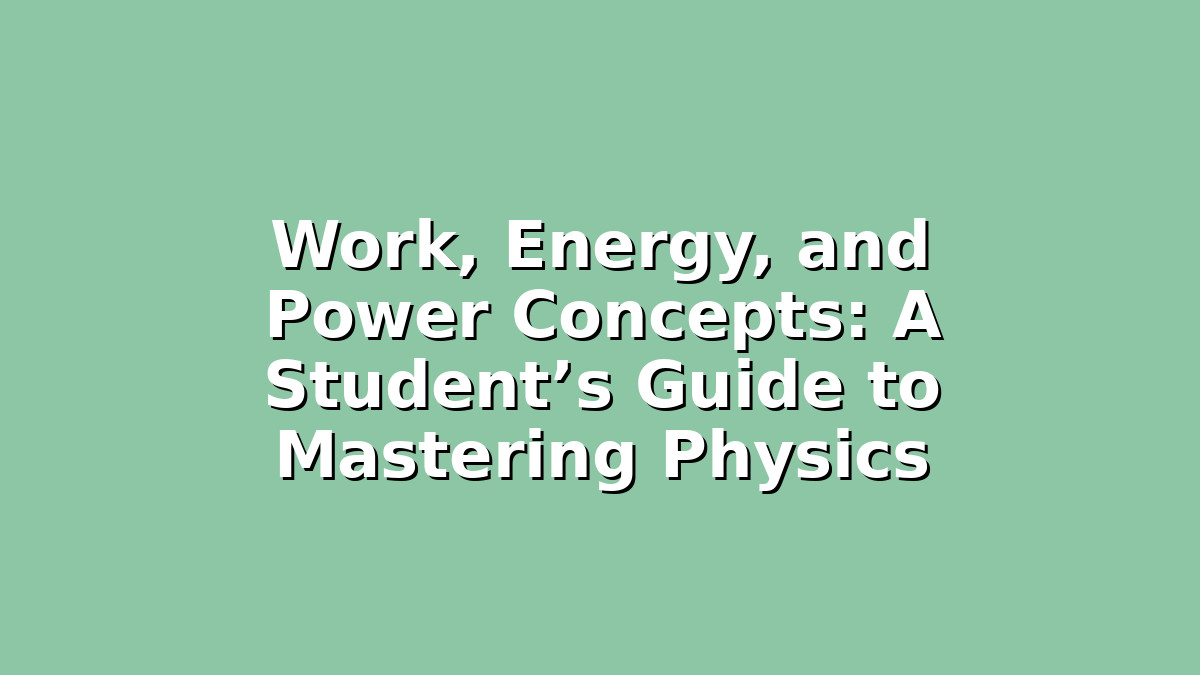When preparing for exams in physics, some topics can feel especially challenging. Work, energy, and power are fundamental concepts that often appear in tests and practical problems. Understanding these ideas deeply not only helps you solve questions more effectively but also builds a solid foundation for advanced physics topics. In this guide, we’ll break down the concepts of work, energy, and power, explore how they relate to each other, and share practical study tips to help you master them with confidence.
Understanding Work in Physics
In physics, work is done when a force causes an object to move in the direction of that force. The basic formula for calculating work is:
[ text{Work} = text{Force} times text{Distance} times cos(theta) ]
where:
– Force is the push or pull on the object (measured in newtons, N),
– Distance is how far the object moves (measured in meters, m),
– (theta) is the angle between the force and the direction of movement.
If the force and displacement are in the same direction, (cos(theta) = 1), so work simplifies to force times distance.
Why is work important? Work quantifies how much energy is transferred by force. Positive work means energy is added to the system, while negative work means energy is taken out.
#### Study Tip: Visualize the Problem
When tackling work problems, sketch the scenario. Draw the force vector, displacement vector, and label the angle between them. This visualization helps you decide whether to include (cos(theta)) and makes it easier to set up the equation correctly. Practice with different angles to become comfortable with using the cosine component.
Exploring the Concept of Energy
Energy is the capacity to do work. The two most common forms you’ll encounter are kinetic energy and potential energy.
– Kinetic Energy (KE) is the energy an object has because of its motion. The formula is:
[ KE = frac{1}{2} m v^2 ]
where (m) is mass (kg) and (v) is velocity (m/s).
– Potential Energy (PE) is the stored energy due to an object’s position or configuration. For gravitational potential energy near Earth’s surface:
[ PE = mgh ]
where (m) is mass (kg), (g) is acceleration due to gravity (9.8 m/s²), and (h) is height (m).
The work-energy theorem states that the total work done on an object equals its change in kinetic energy. This connection often appears in exam questions.
#### Study Tip: Use Real-Life Examples
Relate energy concepts to everyday activities. For example, when you lift a book onto a shelf, you’re increasing its potential energy. When a car speeds up, its kinetic energy increases. By tying abstract formulas to tangible experiences, you’ll find it easier to remember and apply these concepts.
Power: The Rate of Doing Work
While work tells us how much energy is transferred, power tells us how quickly that transfer happens. The formula for power is:
[ text{Power} = frac{text{Work}}{text{Time}} ]
Power is measured in watts (W), where 1 watt = 1 joule per second.
For example, if two people do the same amount of work lifting boxes but one does it faster, that person is using more power.
#### Study Tip: Practice Unit Conversions and Calculations
Power problems often require converting units (e.g., minutes to seconds, kilowatts to watts). Make sure you’re comfortable with these conversions as they make your answers accurate and exam-ready. Also, practice calculating power in different contexts, such as mechanical devices or biological systems (like human power output during exercise).
Putting It All Together: Study Strategies for Success
1. Create Summary Sheets: Write down formulas and key points for work, energy, and power on one sheet. Organizing information visually helps with quick revision.
2. Solve a Variety of Problems: Work on numerical problems involving different forces, angles, velocities, and time intervals. The more varied your practice, the better you’ll understand nuances and avoid common mistakes.
3. Use Flashcards for Definitions and Units: Include terms like work, kinetic energy, potential energy, and power, along with their units and formulas. Flashcards are excellent for memorizing and reinforcing fundamental concepts.
4. Connect Concepts Through Mind Maps: Map how work relates to energy and how energy relates to power. Seeing these relationships graphically can improve your conceptual clarity.
5. Simulate Exam Conditions: Time yourself solving problems without notes. This builds confidence and helps identify areas where you need more practice.
Encouragement for Students
Remember, physics is a subject where practice and understanding go hand in hand. Don’t be discouraged if concepts like work, energy, and power seem difficult at first. Break down problems step-by-step and use diagrams to visualize situations. If you get stuck, review your basics or ask a teacher or peer for help. Consistent effort will pay off, and soon these concepts will become second nature.
Conclusion
Mastering work, energy, and power is crucial for excelling in physics exams and for building a strong foundation in science. By understanding the formulas, relating them to everyday experiences, and practicing regularly, you can confidently tackle any question related to these topics. Use the study tips shared here to organize your preparation and stay motivated. With dedication and focus, you’ll not only improve your exam scores but also deepen your appreciation for the fascinating physics that govern the world around us.
Good luck with your studies—keep working hard, and you’ll power through your exams!

Responses